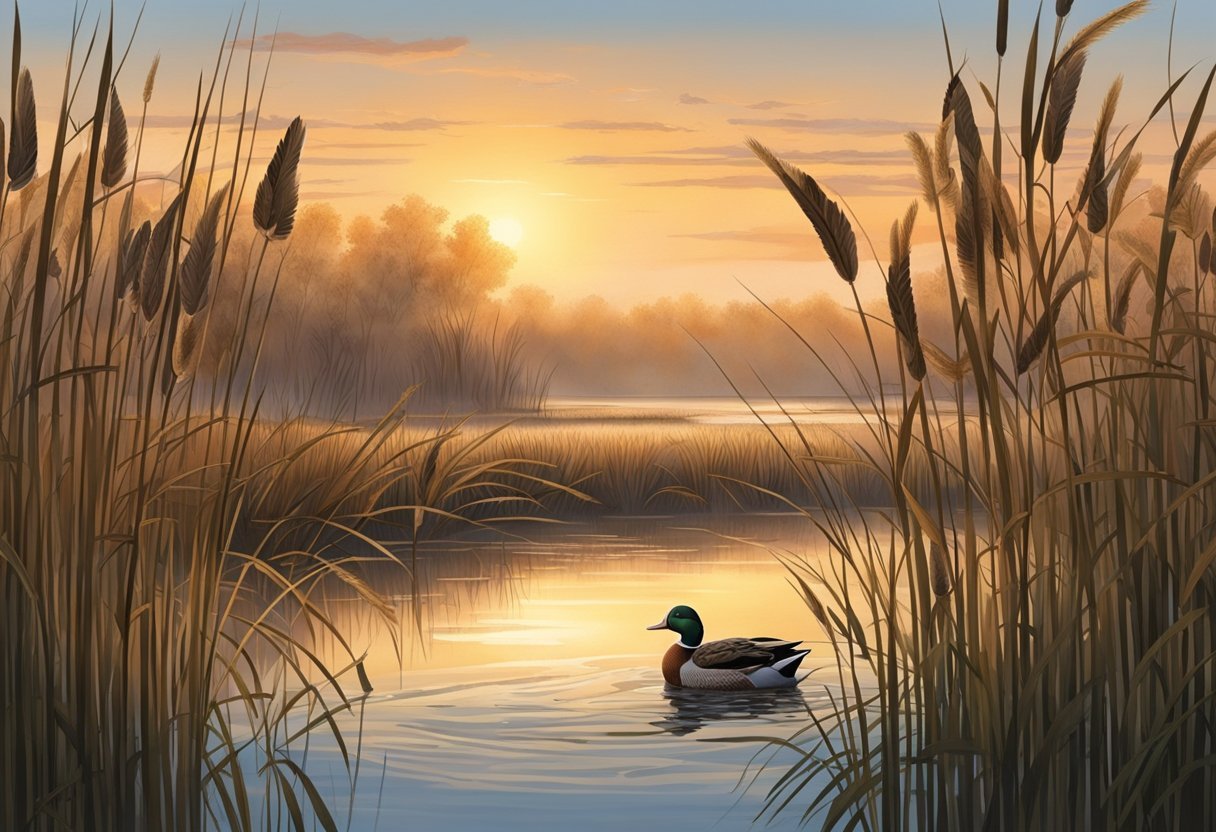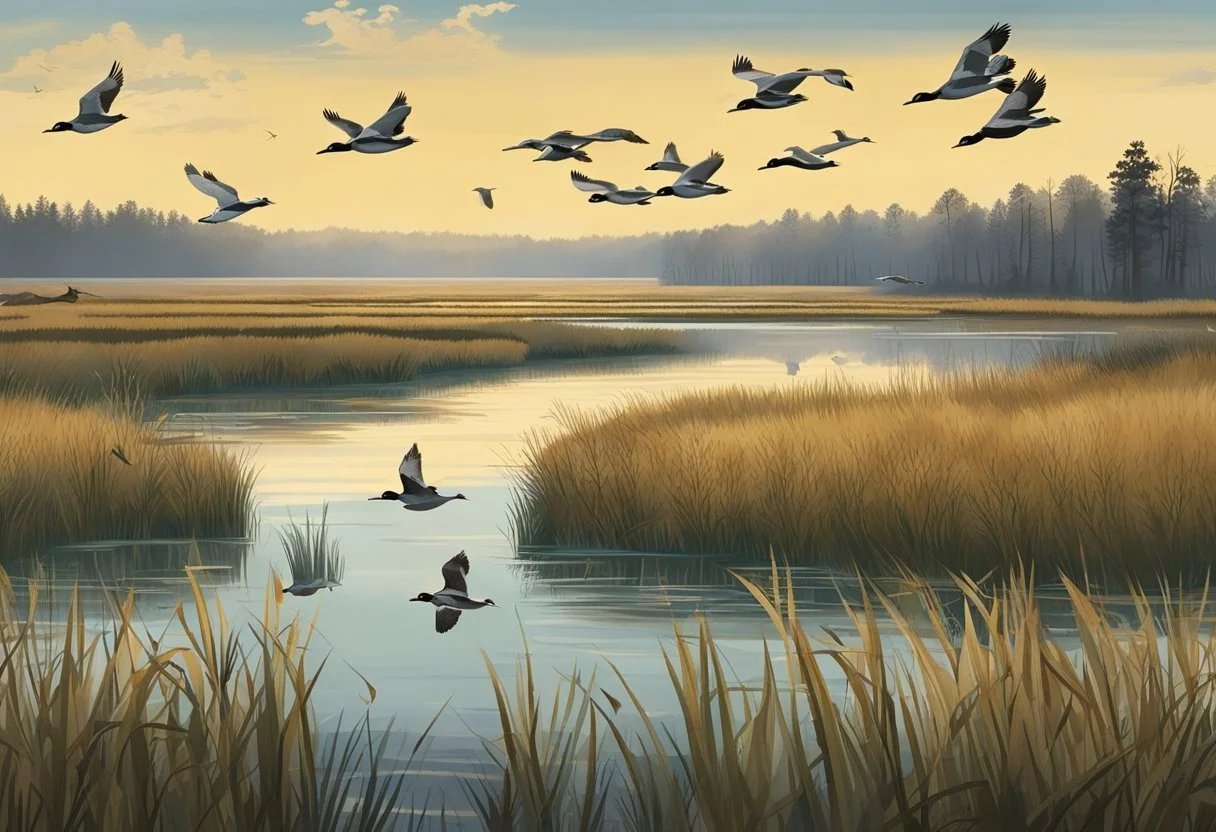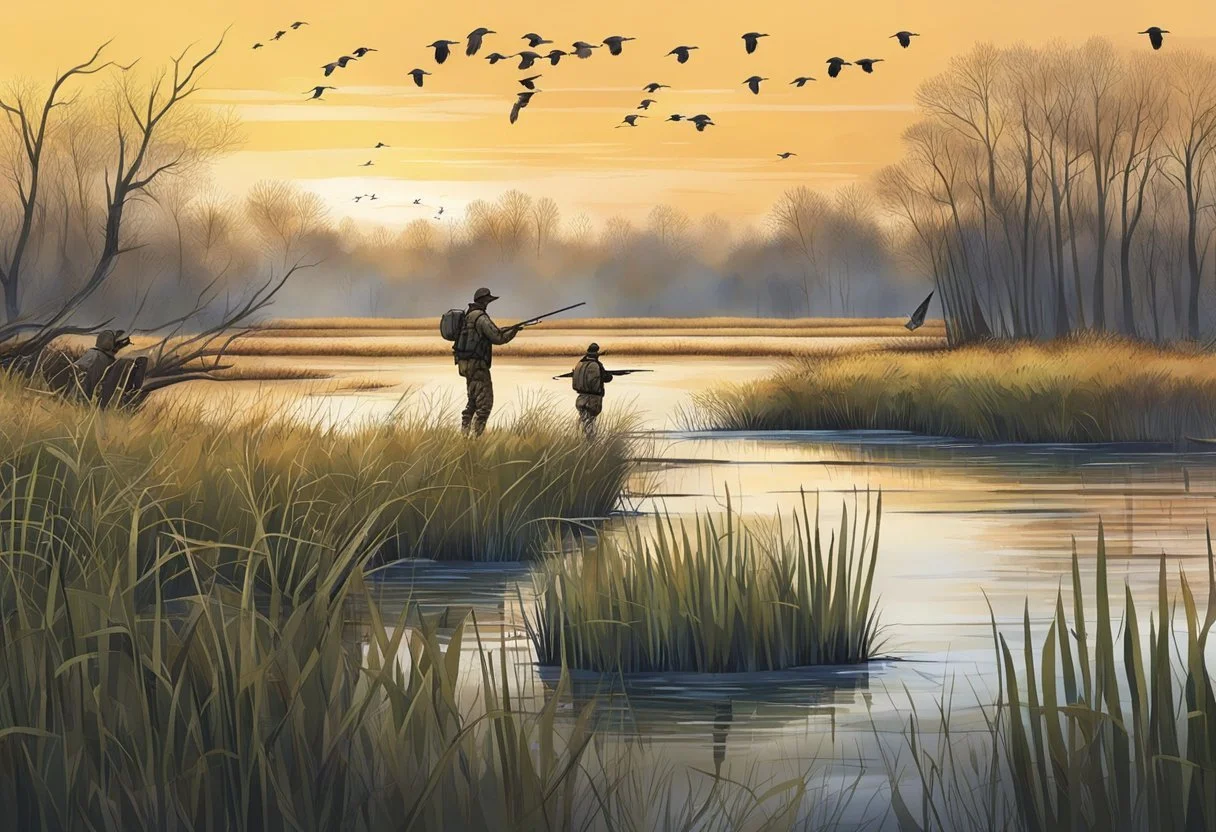Best States for Duck Hunting
Top Locations and Seasons Revealed
Discover > Texas Outdoorsman > Best States for Duck Hunting
Duck (What wine goes well with duck?) hunting has a rich tradition across the United States, with enthusiasts from different regions passionate about finding ducks in their preferred hunting grounds. As migratory birds, ducks can be found in various states throughout the year, making the choice of the best states for duck hunting a subjective matter. Nonetheless, there are specific states that stand out for their exceptional opportunities, blend of species, and supportive hunting policies.
In determining the best states for duck hunting, some essential factors should be taken into consideration. These factors include the available species of ducks, habitat, migration patterns, and state regulations. Additionally, the quality of hunting experiences, private and public lands, hunting access, and overall hunting culture within the state play a vital role in forming the list of the best duck hunting states to hunt ducks.
Several states have earned reputations as great duck hunting opportunities due to their unique combination of these factors, which is why every duck hunter takes advantage in duck season.
Understanding Duck Hunting
Duck Species and Habitats
Duck hunting offers a diverse and exciting experience for hunters, as there are numerous duck species with varying habitats and behaviors. Some popular duck species targeted by hunters include:
Mallard: Mallards are the most common and widespread duck species. They can be found in various wetland habitats, such as marshes, ponds, and lakes.
Pintail: Pintails are slender, long-necked ducks that prefer large, shallow wetlands and flooded agricultural fields.
Gadwall: Gadwalls are medium-sized ducks that inhabit marshes, ponds, and lakes, similar to mallards.
Wood Duck: Wood ducks are known for their striking plumage and unique nesting habits, as they nest in tree cavities near water sources.
Migratory Flyways and Patterns
Ducks and other waterfowl species often travel vast distances during their migration, following four main migratory flyways in North America:
Atlantic Flyway
Mississippi Flyway
Central Flyway
Pacific Flyway
These flyways are critical to waterfowl conservation, as they provide essential rest stops and feeding areas for migratory birds. Hunters who are familiar with these flyways and the timing of migrations can plan their hunting trips to coincide with the highest concentrations of ducks.
Understanding regional and local migration patterns is also essential for a successful duck hunt. For example, some species like mallards and pintails tend to migrate in large flocks, known as "rafts," while wood ducks often travel in smaller groups or pairs.
Duck Hunting Regulations
Duck hunting is regulated to ensure the conservation of waterfowl species and their habitats. Hunters must adhere to federal and state regulations, which may include:
Obtaining a valid hunting license and waterfowl stamp
Adhering to established hunting seasons and bag limits
Using non-toxic shot, such as steel or bismuth, instead of traditional lead shot
Following specific regulations that pertain to a particular species or area
Top States for Duck Hunting
Central Flyway States
Some of the best duck hunting among Central Flyway states can be found in Kansas, North Dakota, Nebraska, Colorado, and South Dakota. Each of these states offers unique experiences, with Kansas showcasing diverse habitats in the form of marshes, flooded fields, and lakes, while North Dakota boasts the prairie pothole region, making it an excellent location for a variety of ducks. Hunters praise the best duck hunting in North Dakota with excellent dry field hunting with fat greenheads that never gets old.
Kansas: Cheyenne Bottoms Wildlife Area, McPherson Valley Wetlands
North Dakota: Devils Lake, Chase Lake National Wildlife Refuge
Nebraska: Rainwater Basin, Calamus Reservoir
Colorado: North Sterling Reservoir State Wildlife Area, Barr Lake State Park
South Dakota: Lake Oahe, Sand Lake National Wildlife Refuge
Mississippi Flyway States
The Mississippi Flyway is known for its abundance of ducks, making Arkansas, Louisiana, Illinois, Minnesota, Wisconsin, and Kentucky excellent states for seeking waterfowl. In particular, Arkansas and Louisiana are the crown jewels of duck hunting in this region, featuring vast bottomland hardwood forests and nutrient-rich wetlands.
Arkansas: Bayou Meto Wildlife Management Area, Stuttgart region
Louisiana: Catahoula Lake, Venice region
Illinois: Mississippi River Pools, Rend Lake
Minnesota: Agassiz National Wildlife Refuge, Lac qui Parle Wildlife Management Area
Wisconsin: Horicon Marsh, Crex Meadows Wildlife Area
Kentucky: Ballard Wildlife Management Area, Barren River Lake
Atlantic Flyway States
The Atlantic Flyway states, while not as renowned as their counterparts, still offer many fruitful waterfowl hunting opportunities. Key states for duck hunters here are New York, Florida, Massachusetts, and North Carolina. These states harbor important migratory routes for waterfowl, with New York's abundance of inland lakes and Florida's unique coastal ecosystems.
New York: Montezuma National Wildlife Refuge, Long Island's South Shore
Florida: Lake Okeechobee, Merritt Island National Wildlife Refuge
Massachusetts: Plum Island, Cape Cod National Seashore
North Carolina: Outer Banks, Mattamuskeet National Wildlife Refuge
Pacific Flyway States
Finally, the Pacific Flyway states offer remarkable duck hunting opportunities, especially in California, Montana, Arizona, Alaska, and Washington. California tops the list with its diverse landscape, mild weather, and abundance of waterfowl species.
California: Sacramento Valley, San Francisco Bay Area
Montana: Freezeout Lake, Benton Lake National Wildlife Refuge
Arizona: Havasu National Wildlife Refuge, Cibola National Wildlife Refuge
Alaska: Cook Inlet, Yukon Delta National Wildlife Refuge
Washington: Skagit Wildlife Area, Gray's Harbor National Wildlife Refuge
Hunting Environments and Hotspots
Wetlands and Marshes
Wetlands and marshes are prime locations for waterfowl hunting due to their abundant food sources and resting areas for migrating ducks. The Mississippi Flyway and Atlantic Flyway are known for their extensive marshlands, including the chenier plains and coastal marshes. These are some of the best duck and waterfowl hunting areas in states, including the White River National Wildlife Refuge and Susquehanna Flats.
Mississippi Flyway
White River National Wildlife Refuge
Chenier Plain
Atlantic Flyway
Susquehanna Flats
Coastal Marshes
Rice Fields and Flooded Timber
Rice fields and flooded timber offer unique hunting environments as they provide both food and cover for ducks. The Central Flyway and Pacific Flyway are well-known for their rice fields and flooded timber areas, with the Sacramento Valley being a popular location for the best duck hunting.
Central Flyway
Sacramento Valley
Rice Fields
Pacific Flyway
Flooded Timber
Rice] Fields
Coastal and Inland Lakes
Coastal and inland lakes provide excellent habitats for ducks migrating waterfowl everywhere, particularly during the fall migration and seasons. The Upper Mississippi River region in the Mississippi Flyway is a hotspot for some of the best duck hunting states, with countless lakes and waterways attracting various waterfowl species. In the Pacific Flyway, hunters can also find plenty of lakes perfect for waterfowl hunting.
Mississippi Flyway
Upper Mississippi River
Inland Lakes
Pacific Flyway
Coastal Lakes
Inland Lakes
Hunting Techniques and Strategies
Decoys and Calls
Many waterfowl hunters use decoys and calls to entice ducks within shooting range. Decoys, which can be made of wood, plastic, or foam, mimic the appearance of ducks and should be placed strategically on the water to create the illusion of a natural duck gathering. Waterfowl hunters typically use a combination of drake (male) and hen (female) decoys. Waterfowl hunters calls, on the other hand, mimic duck sounds to draw them closer. Remember to practice and master various calls before attempting to use them live in waterfowl hunting.
Decoy setup: Duck hunters set up decoys in a U or V pattern is common, with the opening facing the hunter's blind or boat.
Call types: Basic calls include the greeting call, feed call, comeback call, and hail call. Knowing when to use each call is essential for a successful hunt.
Boats and Blinds
A vital aspect of duck hunting is concealment. Boats and blinds provide cover for the waterfowl hunter, allowing them to blend in with their surroundings. Choose the appropriate boat and blind based on your hunting location and conditions.
Boats: Key considerations when selecting a duck hunting boat include stability, capacity, and material (e.g., aluminum, fiberglass). Boats with a flat bottom or a sneak boat design work well in shallow waters.
Blinds: Blinds can be permanent structures (e.g., pit blinds) or portable (e.g., layout blinds, pop-up blinds). Materials to camouflage the blind include natural vegetation, netting, or commercially made products.
Seasonal Considerations
Aware of the season and the weather conditions are crucial for duck and goose hunters success. In early, milder seasons, ducks and geese are often more abundant but warier of hunters. During the colder months, ducks are more concentrated but may be more inclined to rely on decoys and calls due to limited food sources.
Season Considerations Early duck season: Warm temperatures may keep ducks from moving often. Consider scouting before hunting. Mid-season Ducks migrate from colder regions; new ducks may be unfamiliar with hunting pressure, providing an advantage. Late season Cold weather consolidates ducks in small pockets where food is available. Watch for signs of duck activity.
Public hunting lands have different regulations and restrictions, so be sure to familiarize yourself with these rules before heading out.
Access and Opportunities
Public Lands and Wildlife Refuges
The United States is home to numerous public lands and National Wildlife Refuges that provide exceptional duck hunting opportunities. Several National Wildlife Refuges are properties managed by the Bureau of Land Management, where these areas are carefully regulated to balance recreation with wildlife conservation.
Some notable hunting locations include the Upper Mississippi River National Wildlife and Fish Refuge, which spans four states and offers a vast expanse of wetlands, and Cheyenne Bottoms Wildlife Area in Kansas, one of the largest inland wetland systems in North America.
In addition to wildlife refuges, there are also Wildlife Management Areas specifically designated for public hunting, providing even more opportunities for hunters of ducks and geese. Wildlife Management Areas are intended to minimize disturbance to sensitive or endangered wildlife and their habitats, such as bird nesting, resting or feeding areas, and turtle nesting beaches. The Wildlife Management Areas are extensive stretching to more than 230,000 acres of state school lands and waterfowl production areas just in North Dakota.
Private Land Hunting
While hunting on public lands can be a great option, many experienced duck hunters prefer the lesser-known opportunities hunt waterfowl found on private lands. Private land hunting can provide increased chances of success due to reduced hunting pressure and more predictable waterfowl patterns and wintering areas.
To hunt on private land, it's essential to seek permission from the landowner. In some cases, landowners may offer access for a fee or through a formal lease agreement. This exclusivity can lead to more successful and enjoyable hunting experiences.
Guide Services and Outfitters
For those looking to maximize their duck hunting experience, there are countless guide services and outfitters available that specialize in waterfowl hunting. Ranging from simple day trips to more extensive packaged experiences, these services provide expert guidance, equipment, and local knowledge to ensure a successful hunt.
Here are a few key benefits of using a guide service or outfitter:
Local knowledge: Experienced guides know the best spots and strategies for hunting ducks in their area.
Equipment and gear: Many guide services provide high-quality gear and equipment, such as decoys, blinds, and boats.
Hassle-free experience: Outfitters often handle logistics, such as license procurement and transportation, making the entire hunting experience more seamless and enjoyable.
Conservation and Management
The United States has a rich history of conservation and management efforts aimed at preserving and enhancing its wetland habitats, particularly for the benefit of waterfowl hunters. This section will briefly look at three critical aspects of these efforts: habitat restoration, regulatory initiatives, and waterfowl hunters involvement.
Habitat Restoration
Habitat restoration is crucial for the sustainability of duck populations and their ecosystems. Efforts to restore wetland habitats, such as prairies and prairie potholes, have significantly improved the living conditions of various species of ducks harvested both diving and dabbling ducks, as well as coastal birds like sea ducks.
Some notable initiatives include:
Prairie Canada: Projects aimed at conserving and enhancing prairie landscapes across Canada, a crucial breeding ground for migratory birds in North America.
Prairie Potholes: Efforts to preserve and restore prairie pothole habitats in the United States, which provide essential nesting grounds for ducks and geese.
These restoration efforts not only benefit the duck species but also the natural resources that contribute to the grand landscapes of North America, ensuring a healthy and balanced ecosystem.
Regulatory Initiatives
Numerous regulatory initiatives have been implemented to ensure sustainable conservation, management, and use of wetland habitats for duck hunting. Some examples are:
Migratory Bird Treaty Act: Regulates the hunting and protection of migratory birds, including ducks and geese, across the United States, Canada, and Mexico.
Federal Duck Stamp Program: Requires waterfowl hunters to purchase a stamp, proceeds of which go to the conservation and preservation of wetlands.
By focusing on these initiatives, authorities can manage and monitor the impact of waterfowl hunters on the various species and ecosystems, promoting long-term sustainability.
Hunter Involvement
The involvement of hunters in conservation and management efforts is vital for the success of habitat restoration projects and regulatory initiatives. Hunters often take part in:
Education: Learning about species identification, best hunting practices, and habitat conservation.
Volunteering: Assisting in habitat restoration projects or organizing fundraisers for conservation efforts.
Advocacy: Acting as ambassadors for the importance of wetland conservation and responsible hunting.




